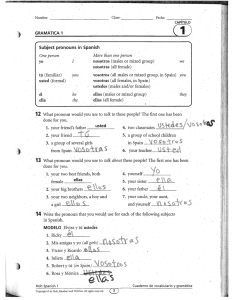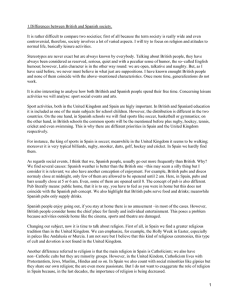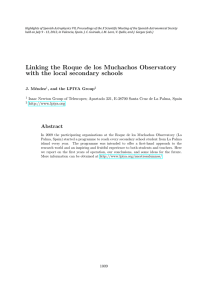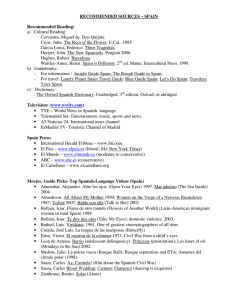Comparison of European Models of Public Procurement Focused on
Anuncio
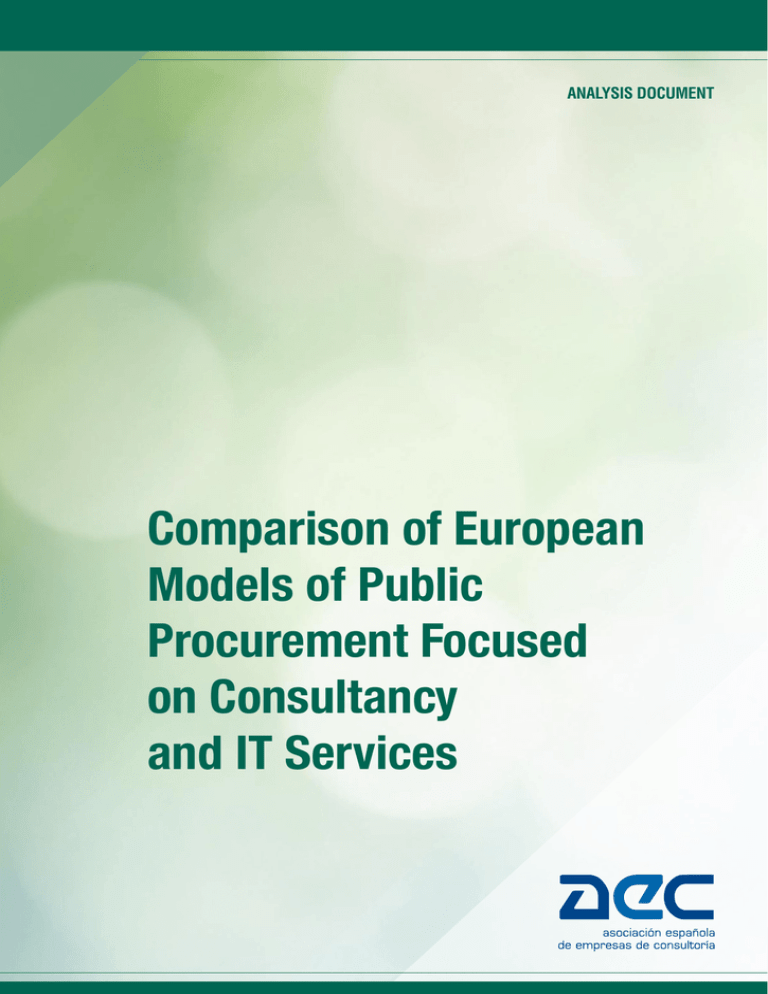
analYsis Document Comparison of European Models of Public Procurement Focused on Consultancy and IT Services 1 Comparison of European Models of Public Procurement Focused on Consultancy and IT Services 1. Introduction The economic crisis is generating a considerable impact in Spain on the procurement of consultancy and IT services by the Public Sector. This impact can be appreciated most clearly in the heavy price reductions, with the subsequent tensions caused in contracting. Furthermore, it can also be seen, and positively, in the willingness and search for formulas for the application of new contracting procedures such as Public-Private Partnership agreements. In the light of this situation, the Spanish Association of Consulting Firms (Asociación Española de Empresas de Consultoría, hereinafter AEC) has considered it appropriate to perform a comparative study between countries of reference in Europe, to allow the differences in the application of the contracting regulations to be seen in situ and to detect their best practices with the aim of proposing routes for improvement to the Spanish Public Administration. The countries and institutions selected, owing to their own relevance and due to their use of advanced public procurement practices, are: • • • • • • France. United Kingdom. Germany. Denmark. The Netherlands. European Commission. For the collection of information in each one of the countries, a questionnaire has been distributed to the offices of the AEC companies with significant presence in those countries. The information has, in turn, been completed with the information on public procurement for 2011 of the European Union collected in www.ted.europa.eu (Tenders Electronic Daily). With regard to the Spanish case, the same questionnaire has been used, distributed in this case to all the AEC companies. Furthermore, the information on public contracts has been complemented by the “IT Services Report for 2011” and the “IT Services Report for the 1st semester of 2012” performed by LICITA and commissioned by the AEC. 2. Award procedures There are considerable differences in the use of procedures depending on the countries. In broad outlines, the open procedure is prominent in Spain and France, the restricted procedure in the United Kingdom and Denmark, and the negotiated procedure in Germany. In Spain, competitive dialogue is testimonial with six tenders and two organisations (0.3%). 2.1. Open procedure The aim is that any businessperson interested can make a proposal. Spain is the country where most use is made of the open procedure with more than 80% of cases, almost 30 points more than the average, 14 points above France and very far from the United Kingdom (19%) or Germany (43.4%). 2 2.2. Restricted procedure It is considered for the submission of proposals made by the business people who, on request and based on their solvency, will be selected by the contracting authority. The United Kingdom is the country where the restricted procedure is most used with 56% of cases and Spain uses it the least with a token of 1.7%. In the United Kingdom, procurement via the restricted procedure is especially relevant in Ministries/ Federal Organisation with more than 63% of the procedures. Denmark deploys similar behaviour with contracting in Ministries of more than 70%. In Germany, it is less widespread with significant use in Regional Offices/Bodies of 26.32%, still far higher than Spain. 2.3. Competitive dialogue It is characterized by the contracting authority leading a dialogue between the successful applicants in order to develop a solution which will be the basis for the submission of the proposal. Competitive dialogue, although very limited in its use, is prominent in the United Kingdom (12% of tenders) and in France (4.2%) although, in France, more procedures have been presented in the market in absolute value in 2011 than in the United Kingdom. In Spain, it is still very little implemented (partly owning to its nature and approach) and its insignificant use is also reflected with a difference of 11 points compared to the United Kingdom (the maximum user). This procedure uses a tenth (in terms of percentages) of the average for the rest of the countries in the study. Since in Spain, in the majority of cases, competitive dialogue is previous to the existence of a Public-Private Partnership agreement, there should be an intensification of its use taking into account the limitation of the Public Authorities with regard to their investment capacity. It would allow the execution of projects that are feasible both for the Public Authorities and for industry which would lead to benefits for all. The current situation of the public sector with limited investment resources should promote its use. ❒ In Spain special mention is deserved by the minimal use of the restricted procedure in comparison with the high use of the open procedure. ❒ C ompetitive dialogue is very little implemented. The obligatory nature of its use for entering into a Public-Private Partnership agreement should promote its use. ❒ It is appropriate to ask: What are the reasons for these differences between the countries of our environment? Does the excessive abuse of the open procedure not hide a limited requirement in terms of solvency which seems to be more established in other types of procedure such as restricted, negotiated and competitive dialogue? What impact could these forms of procurement have with regard to the quality of the work and the excessive pressure on prices in IT services? 3 Comparison of European Models of Public Procurement Focused on Consultancy and IT Services 3. Systems for the rationalisation of procurement In the countries analysed, auctions and electronic procurement systems are not greatly developed. European law, in the case of electronic systems, will stimulate their implementation. The use of central purchasing bodies is uneven in these countries and truly relevant practices are not detected. 4. Public-Private Partnership agreement contracts The surveys reflect a low level of use of contracts of this type in the IT sphere in the institutions and countries analysed, including the European Commission. In this respect, Spain is in line with the European trend. If it is considered that the Competitive Dialogue procedure implies a de facto PPPA, and we can measure its use during 2011 at an average of around 4%, the United Kingdom with 12% and France with 4% being prominent. Spain would be represented at 0.4% in that same year. With regard to the characteristics of the PPPA, a certain standardisation is observed in all the countries: • • • • The objective is obtaining private funding, distribution of risks and tasks. They are complex contracts, very expensive and of long duration (between 10 and 20 years). Requirement for a high level of technical or financial solvency. Low number of bidders. ❒ N o country stands out for the application of this type of contracts for IT services, beyond occasional experiences. 4 5. Technical specifications No relevant differences are seen between the different countries analysed in the structure, content and quality of the technical specifications. According to the surveys, the main points for which we are in worse conditions in Spain are depicted in the degree of standardisation of the information and the absence of methodologies to assist in their preparation. It is also striking how in the rest of the countries the outsourcing of the preparation of technical specifications is a generalised practice. ❒ It would be advisable to advance in the development of a methodological guide for the preparation of technical specifications. 6. Award criteria The Netherlands and Denmark are the most advanced countries in this section and they have standardised methodologies and tools for the establishment of the awarding criteria and the assessment of proposals itself. The rest of the countries, as is also the case of Spain, do not have generalised methodologies in this respect. Regarding the distribution of weights between criteria subject to value judgments (qualitative) and directly objective (quantitative) criteria, the average is 50/50. No practical application would exceed 60 percentage points for the criteria subject to value judgments with the exception of Denmark where there appears to be no objection to establishing the totality of the evaluation with subjective criteria. Likewise, there appears to be no legislation that establishes a maximum limit for these criteria above which the evaluation should be made in a special manner. Here, the exception is the Spanish case, where above a certain limit it is mandatory to establish an independent commission for its assessment. Regarding the importance of price in the awards, a general trend is observed for the application of a higher relevance to the acquisition of hardware and software compared to IT services and consultancy. A scale of reference, by way of example, may be the German case (it is in the high band of weight for price) where the average weights are calculated at 80% for hardware and software, 60% for IT service and 50% for consultancy services. To concentrate the analysis on IT services, the average band for the weight of the price is in the range of 20-60%, there being no country that exceeds this limit. The average can be calculated at 40%. Germany is the country with the highest weights in general. In Spain, the average weight of the price in tenders for IT Services (consultancy, development, integration and outsourcing) is calculated for 2011 at 45%. This value is calculated according to the mean of 5 Comparison of European Models of Public Procurement Focused on Consultancy and IT Services all the public tenders in the period, weighted by the amount. This value is broken down according to the type of administration as follows: • National State Administration: 51%. • Autonomous Regions: 39%. • Local Authorities: 39%. Likewise, the same study having been repeated for the first six months of 2012, the average amounts to 58%, which represents a considerable increase and the confirmation of a rising trend in the preponderance of price. By type of administration, the most significant increase takes place in the Autonomous Regions. The breakdown is as follows: • National State Administration: 55%. • Autonomous Regions: 62%. • Local Authorities: 47%. Lastly, no practice enables the use of the price criterion as the sole criterion for the evaluation of offers. ❒ It would be recommendable to advance in the preparation of a methodological guide for the establishment of awarding criteria. ❒ O n average, in the countries of reference the distribution of the weight of objective and qualitative criteria for IT services is 50/50%. ❒ T he average weight of price in the countries evaluated is 40%. In Spain, the average calculated for the first six months of 2012 is 55%, a considerably higher figure. Likewise, a worrying trend is observed in Spain towards increasing the weight of price in procurements. 7. General strategy for the management of technologies This section analyses, in general, the strategy for the carrying out of IT projects and services. In the case of consultancy services there is no predominant model, closed projects and technical assis­ tance being used indistinctly. In the case of application services, and from the point of view of resources, the relative weight of external resources compared to total resources exceeds 50%, France and Denmark being the countries with a higher relative presence of external resources. Regarding the service management model for the development and maintenance of applications, the application of SLAs (Service Level Agreements) is the dominant practice and trend. In this case, Denmark and the United Kingdom are the countries of reference. 6 The use of the AaaS (Application as a Service) mode is also quite extended, the main references being the United Kingdom and the Netherlands. The offshoring of services is not prominent in any of the countries analysed. In the case of infrastructure services, a higher presence of external resources compared to total resources is observed than for application services. In this case, France and Denmark are the countries with the highest proportion, exceeding 70% in both cases. As with the application services, the application of the SLA is the dominant contracting method. In­ frastruc­ture as a Service (IaaS) is a growing trend. ❒ T he weight of external resources for application and infrastructure services is situated at above 50%, being higher in infrastructure services, with a growing trend in both cases and with a predominant management model by means of service level agreements. 8. Prices With the data obtained via the surveys, it is seen that the average price for professional services in the countries of reference is far higher than the Spanish average. For the calculation, a study has been performed of eleven professional categories objectivised on the basis of the previous experience required. In the Spanish case, the price frame used in the award of the framework agreement AM26 of the Directorate General of State Assets has also been taken into account. As a result, the average of the prices is 59% higher than the Spanish average, a value that amounts to 67% if Spain itself is excluded from the calculation of this average. To calculate these values the effects of the weight of public expenditure in each of the countries has been taken into account as well as the correction according to per capita income. ❒ T he average price in the countries of reference is between a 59% and 67% higher than the Spanish average. 7 Comparison of European Models of Public Procurement Focused on Consultancy and IT Services 9. CONCLUSIONS To sum up, the main characteristics of the Procurement of Consultancy and IT Services from the pu­blic sector in Spain can be outlined as follows: • Spain is the country that most frequently resorts to open selection procedures (in 80% of the cases, which means 14% more than France, 19% more than UK, and 43% more than Germany), whereas restricted procedures and competitive dialogue procedures linked to the public-private partnership contracts have not been widely adopted. • The importance of price in the IT awards stands at 40%, on average, in the European countries and institutions, whereas in Spain it stands at 58% in 2012. • Denmark and the Netherlands are the most advanced countries with regard to award criteria, since they use standardized tools and methodologies for the award criteria and the assessment of proposals. Neither Spain nor the rest of countries use standardized methodologies for these purposes. • The average of the rates for professional services in the concerned countries amounts to 60% more than in Spain. Therefore, it can be concluded that IT public procurement in Spain is excessively conditioned by price and by the open selection procedures. 8 AEC Members Accenture, Altran, Atos, Ayesa, Capgemini, Cegos, Delaware, Deloitte, Ernst & Young, Everis, GFI, Hay Group, HP, IBM, Indra, Informática El Corte Inglés, INSA, IOR Consulting, Neoris, Oesía, PwC, Sopra Group, Steria, Tecnocom, Telvent, Unisys, VASS and ACEC. Monte Esquinza, 34, 2.° B, 28010 Madrid, Spain Tel.: +34 91 308 01 61 Fax: +34 91 391 35 93 E-mail: [email protected] www.consultoras.org Copyright © 2013 AEC.
